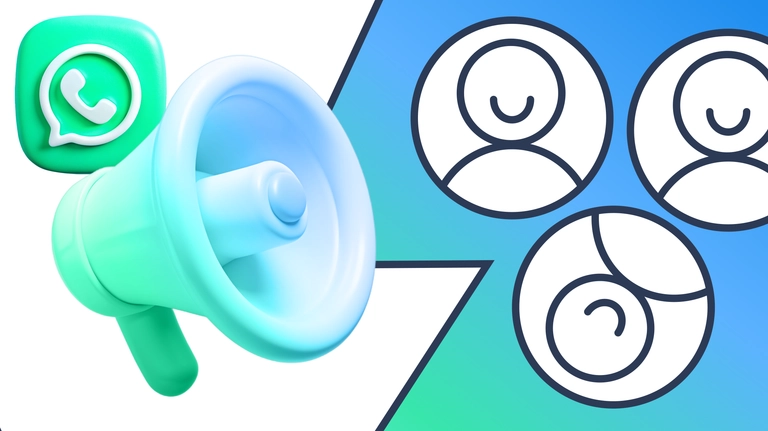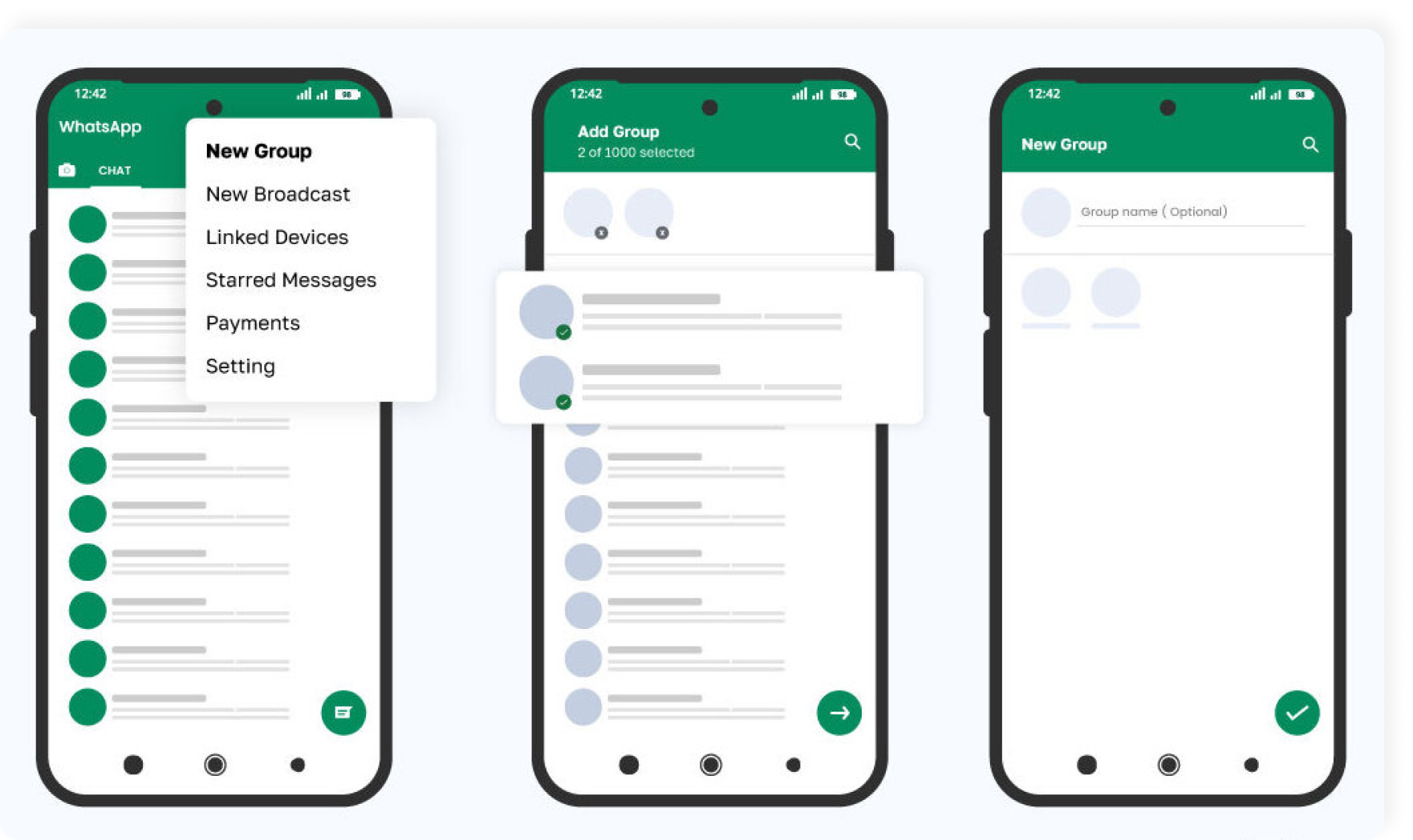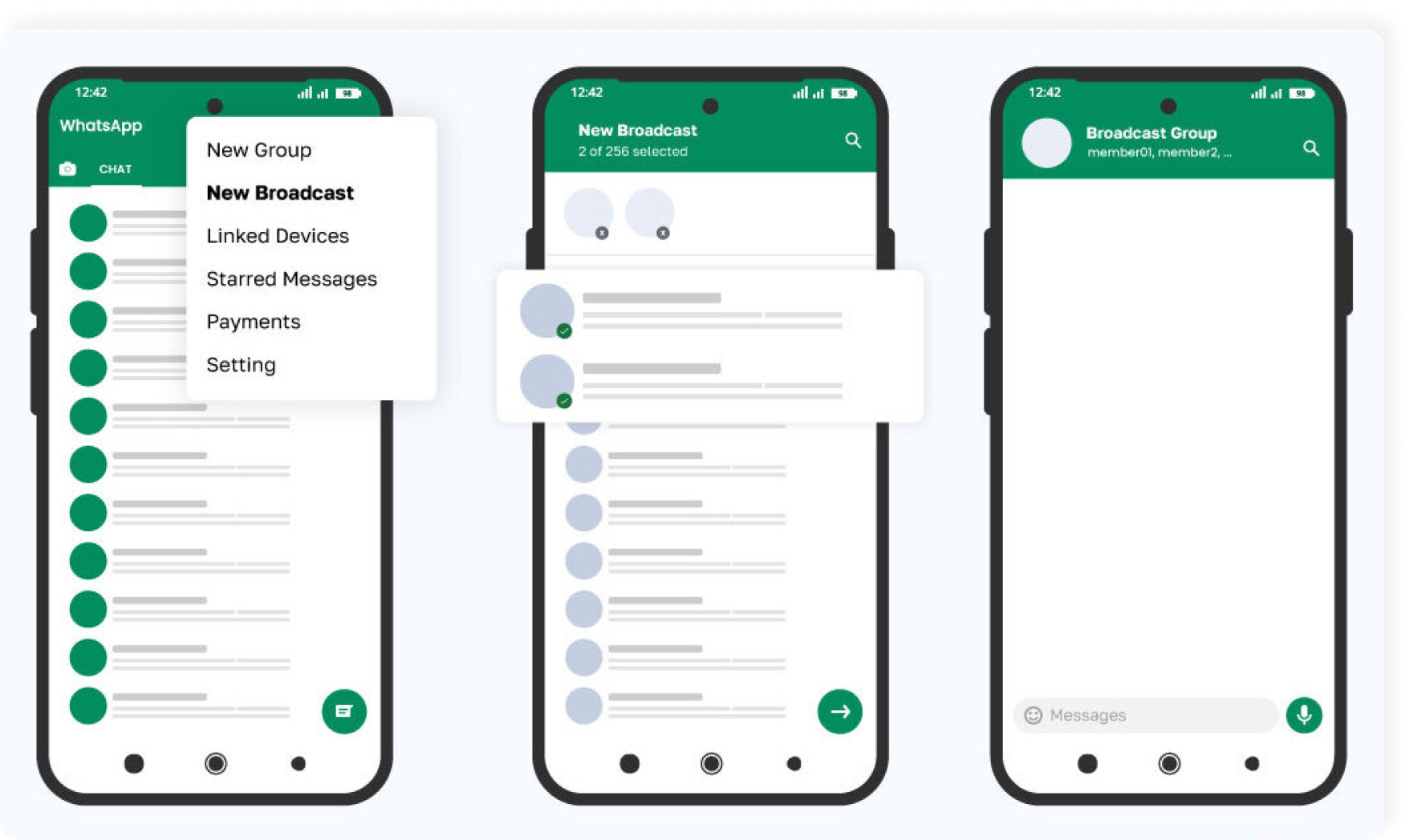
WhatsApp group vs. WhatsApp broadcast: what to use for business
Explore differences between WhatsApp groups and broadcasts to decide the best way to chat or share updates for your business.
Are you wondering about the difference between WhatsApp broadcast (bulk messages) and WhatsApp groups? You're not alone. Many WhatsApp users are unclear about how these two features differ.
In this article, we'll explain the simple distinctions between WhatsApp groups and WhatsApp broadcasts (one to many messages.)
Consider it a quick guide to help you decide on the best way to chat or share updates for your business.
Overview of WhatsApp groups

What is a WhatsApp group?
A WhatsApp group is a powerful tool for chatting with a wide audience in one place. You can send messages, pictures, videos, and files, which is great for group discussions. Admin tools let you add, remove, and change WhatsApp group rules.
💡 Groups are available on personal WhatsApp accounts and the WhatsApp Business app.
WhatsApp group allows up to 1,024 people to chat, which is incredible for businesses and communities to work together, foster engagement, and keep topic discussions in real time.
Key features
Group chats. In a WhatsApp group, you can have topic discussions and instant communication, share photos, and even send voice notes to keep everyone connected and happy.
Admin controls. As the group admin, you have special powers — admin controls. You can choose active users as admins, manage who can change group settings, and keep things organized for effective communication.
Group links. Making the group bigger is super easy with group invite links. It's an effective tool to add new members without the hassle of adding them to your contacts list one by one.
Mentions. When the chat is buzzing, individual messages can get lost in the chat history. But with the '@' mention feature, you can ensure a specific member sees your message.
Use cases
Community engagement
Stay connected with your communities with ease in a WhatsApp group. For example, use it for event planning or to share daily updates, photos, or other content types and important information in one chat and keep everyone in the loop in one place.
Interest-based groups
Connect with like-minded people in your community through WhatsApp groups. Whether you're part of a book club, a neighborhood watch, or a hobby group, easily plan upcoming events, keep ongoing discussions and collaborative interactions, and share valuable content with fellow members.
Networking and collaboration
WhatsApp group functionalities make team projects and collaborative discussions a breeze. Whether for school or work, the popular messaging app allows everyone to share ideas, discuss tasks, and stay updated.
Benefits
Sense of community. A WhatsApp group creates a community and provides a platform for instant, seamless communication among members.
Information sharing. Members can easily share different content (documents, photos, and videos) with everyone right in the group instead of private messages in direct chats.
Coordination and collaboration. It facilitates the coordination of plans and projects, enabling members to navigate through previous conversations and work together efficiently.
Real-time feedback. Members can instantly give and receive feedback, managing decision-making, customer service, and marketing efforts more streamlined.
Accessible anytime, anywhere. Mobile access makes it convenient for members to stay connected and engaged regardless of their location.
Best practices
Clear guidelines. Establish clear rules for group interaction. It helps to promote a respectful and inclusive communication strategy and minimize irrelevant messages and the potential for spam.
Active management. Review collaborative discussions regularly to maintain a positive and engaged community, address any issues promptly, and establish comfortable communication.
Engaging content. Share interesting, relevant, exclusive content and interactive messages to encourage active participation and meaningful conversations.
Challenges and limitations
When dealing with big WhatsApp groups, it's essential to ensure content relevance, minimize the potential for spam, and encourage members to actively participate in interactive discussions to keep a sense of community.
Overview of WhatsApp broadcasts (bulk messages)

WhatsApp broadcasts are also known as bulk messages and one-to-many messages. This feature enables users to send messages to many contacts simultaneously in personal chats without the need to create a group chat.
💡 Broadcast lists are available on the WhatsApp Business app and via WhatsApp API.
Imagine this scenario: you have exclusive content that you want to share with a large customer base as part of your marketing strategy. Fear not, because WhatsApp broadcasts are here to simplify your communication efforts, especially if you are a business owner.
Key features
Creating and managing broadcast lists. You have complete control over who is on your broadcast list. It's like having your own club with contact details. When you send one-way messages in individual chats, recipients feel like they are receiving a special message with valuable content from you, which adds a touch of confidentiality and personal communication. You can also send similar or the same messages to multiple groups of recipients if it fits your marketing strategy.
One-way communication. Unlike a WhatsApp group, a list of recipients in a broadcast can't respond to everyone on the list. This means that when they reply, it becomes a private conversation between just the two of you. No more cluttered group chats, just clear, focused, and efficient communication.
Easy updates. Need to quickly inform a wider audience of thousands of customers about important product updates, company news, or exclusive offers? With WhatsApp broadcast, you don't have to create a group chat. You can easily send bulletins, reminders, or any other promotional content to a broad audience in a matter of seconds.
Use cases
Announcements and updates
In the world of business, getting the word out in a communication channel about a sale or new product is crucial. With WhatsApp broadcasts, you can deliver the news to all your customers via one-way communication, creating the feeling of a personal, special message that grabs their attention.
Daily messages
With WhatsApp broadcast, you can easily send daily workout tips, delicious recipes, or other informative content to your list of recipients. No need to clutter their inbox with a group chat and irrelevant messages — just send it directly and keep them motivated.
Reminders and notifications
Keeping everyone on the same page can be challenging, especially when group chats spiral into chaos. However, with WhatsApp Broadcast, you can send reminders, promotional messages, product launches, and other notifications directly to your contact list of club members or students, ensuring better customer experience with your messaging strategies.
💡Unlock the potential AI-powered WhatsApp broadcasts to reach a wider audience and enhance your communication strategy. With targeted announcements and event promotions, you can tailor your messages for maximum impact and effortlessly engage potential attendees.
Benefits
Efficiency. With WhatsApp broadcast, you can send messages to many contacts per broadcast list at once, saving you time and effort in marketing campaigns. Instead of individually messaging each person or creating a group chat, you can simply send a significant message volume, ensuring that your message reaches everyone simultaneously.
Privacy. Unlike group chats, where every member can see and respond to everyone's messages, recipients in a WhatsApp broadcast can only reply to the original sender. This creates a more personalized and confidential communication experience like in common chat.
Targeted messaging. WhatsApp broadcast allows you to send personalized messages to specific groups of recipients. You can create different broadcast lists based on specific categories or criteria, such as customers, employees, or stakeholders. This targeted approach ensures that the right message reaches the right audience, increasing the effectiveness of your WhatsApp Broadcast communication and customer satisfaction.
Best practices
Personalization. To make your WhatsApp broadcast messages feel personal, you can grab your contacts' attention and increase the chances of a meaningful response or action.
Relevance and frequency. Send timely, valuable, and directly applicable information to your contacts' needs instead of unwanted messages to increase audience engagement and motivate leads to keep following your WhatsApp broadcasts.
Timing. Sending messages at the right time plays a crucial role in the effectiveness of your customer communications via WhatsApp broadcasts. Avoid sending messages during busy business hours or late at night when they are less likely to be read or acted upon.
Clear Call to Action (CTA.) Whether it directs recipients to visit your website, purchase, or respond to a survey, a strong call to action motivates a wider audience to engage and take the desired action. Make sure your call to action is concise, compelling, and easily actionable, guiding your target audience toward the next step you want them to take.
Analyzing the effectiveness. Monitor metrics such as open rates, click-through rates, and response rates to understand the impact of your marketing campaigns. Based on the data, make informed decisions about the types of content, timing, and frequency of your broadcasts. Constantly adapt and refine your approach to deliver better results to a larger audience and improve customer engagement.
Challenges and limitations
Unavailability on personal WhatsApp
Personal WhatsApp accounts cannot create broadcast lists, so users can't send mass messages to multiple contacts like businesses using WhatsApp Business or WhatsApp API. While great for one-on-one or group messaging, this limits users who want to send the same message to multiple contacts without creating a formal group. To overcome this limitation, create a WhatsApp Business account or explore using WhatsApp Business API.
Message deliverability
While broadcast messages can be delivered to all contacts in your list, some may not receive them due to technical issues or network problems. To overcome this challenge in your marketing campaigns, regularly check the delivery status of your messages and follow up with direct customers if needed.
Ensuring engagement
This can sometimes limit the level of engagement and customer interaction within the broadcast. To overcome this limitation, encourage recipients to respond to the broadcast message by including a call to action, quick replies, or asking for their feedback or opinions. This helps create two-way communication and a more interactive and engaging customer experience.
Key differences between WhatsApp groups and broadcast: comparison table
Despite having a 98% open rate (the highest among all messaging platforms), understanding the pros and cons of each WhatsApp tool is crucial for making an informed decision.
Here's a side-by-side comparison:
Features | WhatsApp group | WhatsApp broadcast |
|---|---|---|
Reach | Up to 1,024 members | Up to 256 recipients on the WhatsApp Business app and unlimited via WhatsApp API |
Engagement | Higher (active participation) | Lower (passive reception) |
Communication style | Interactive, two-way communication | One-way communication from a sender to multiple recipients |
Privacy |
|
|
Message delivery | All group members see messages. It allows you to identify and interact with all other members, creating a cohesive community within the chat | Messages are delivered individually to each recipient. It mirrors the experience of crafting tailored, individual messages to a multitude of people, all in a single stroke |
User experience |
|
|
Use cases | Discussions, collaboration, activities, community building | Sending information, announcements, promotional messages |
Setting up WhatsApp group
On iOS
Open WhatsApp and click on the chat icon.
Click on the New Group option from the top right corner.
Select the people you want to add to the group from the displayed list of contacts.
Name your group.
Add a profile picture to the group.
On Android
Open WhatsApp and click three dots on the top right side.
Select the New Group from the dropdown menu.
Select the people you want to add to the group from the displayed list of contacts.
Name your group.
Add a profile picture to the group.
Setting up WhatsApp broadcast
On iPhone
Open WhatsApp or WhatsApp Business → Broadcast Lists → New List.
Select the contacts you want to send your message to and tap Next.
Create your message in the broadcast list.
Tap the back button to view your broadcast list and send your message.
On Android
Tap on the three vertical dots in the top right corner and select New broadcast.
Select contacts to add to your broadcast list and tap the green tick.
Create your message in the broadcast list and send it to the recipients.
By following these steps, you can efficiently create and send broadcast messages to keep your contacts informed and engaged.
Turn your WhatsApp contacts into customers with AI agents
If you're looking for an outstanding business solution to maximize your WhatsApp business communications and turn your contacts into customers, consider AI agents.
With Fuely AI by Chatfuel, you can easily manage each stage of your customer journeys — from first inquiry to post-purchase updates cart notifications, and more. Also, you can use one number to connect unlimited agents, get a green tick mark, and enjoy ChatGPT built-in that interacts with your customers in a human-like manner.
So why not get started free today to scale customer engagement and sales?
